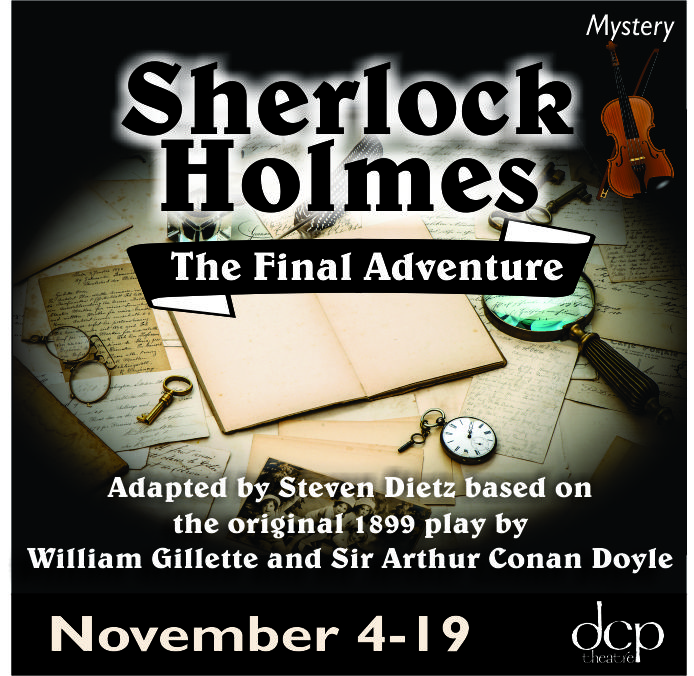Sherlock Holmes is a superhero. His superhuman ability of deductive reasoning and intelligence have delighted readers for generations. The triumphs and travails of bringing a superhero like this to life on stage are as mighty as they are many, so cheers to Dutch Country Players for succeeding in an adept excecution of such deceptively difficult source material. Rightfully and vigorously, they were applauded for their fine work during the crowded matinee performance I attended on Sunday the 6th of November. What remains for us here, dear Watson, is a listing of the causes of this success.
That there is a degree of difficulty in presenting Holmes live on stage is owed first to the nature of Holmes' unique superpower: his power of instantaneous deduction is so perfect, so never wrong as to be a forgone conclusion. This infalliable assuredness, however, threatens to rob live theatre of its vital essence: the excitement of dramatic conflict that rises during uncertain circumstances. With Holmes, nothing is uncertain but for the amount of time it takes the world and the audience to catch up to him.
Adding to this difficulty are the inherent weaknesses of the script. Shattered into small scenes, the text spreads the hero and those in his circle across locations both interior and exterior with little thought as to how a theater company could execute them in succession. Gilette's original script featured about ten different set pieces and Deitz's version adds about nine more. Though there has never been a direct feature film adaptation of Gilette's script (most are drawn from one or bunches of Doyle's stories), Deitz's additional scenes compound and complete the curious feeling that what you are waching is an attempt at an adapted-for-the-stage movie rather than a play.
To their credit, the DCP theatre has fully realized Deitz's interpretation of Gilette's original vision through creative staging and set design combined with formidable technical resources. It's a daunting task yet the technical execution of this show is as good as it gets at this level of local theatre. The set was multi-layered and interactive. Players had as many as six different vertical levels from which to ascend and descend and the entire expanse of DCP's space was used. 221B Baker Street was placed in front of the main stage on a slightly raised platform which garnered some intimacy for the dialogue there, usually between Holmes and Watson. The main stage was divided at times into as many as four different locations at once, between London street exteriors, villain's lair interiors, the back of a speeding train, the lobby and rooms of a Swiss hotels and even more. Utilitartian in term of props and furntiure but not spartan, the Baker Street set included the required pipe rack and victrola. Kudos to Set Designer Ray Thompson and to Mike Addice as Lighting and Sound Designer for harmonizing the effects and elements to capture such a theatrical sprawl.
Regarding performances, it was Teddy Roosevelt who remarked "it is not the critic who counts...credit belongs to the man who is actually in the arena..." As a reviewer, I am unique in that I am not a professional critic but an actor with 17 years of lead and ensemble roles. Any accolades or admonishments I mention here I qualify as a fellow board-trodder, and I have naught but accolades to outlay, starting with Cameron Purdy as the titular consulting detective.
Mr. Purdy was given the heavy lifting of deduction-cum-monologue and did his best to make it dramatic without being didactic. I have seen this feat accomplished before, but not from an actor of Mr. Purdy's youthful visage. Doctor Watson was played with inquisitive exasperation by Michael Romito. Usual casting is for Watson to be the junior of Holmes or at least contemporaries, but here we meet a younger Holmes and a silvery white haired Watson. This can be overlooked by Mr. Romito's resemblance to the current "offical" imgaining of Watson by the actor Martin Freedman on BBC America's hit show "Sherlock". They really do look alike. Mr. Romito as Watson must also fulfill the role of on-stage narrator, stopping to break the fourth wall and inform the audience to those transitions that no live transition of light, sound or spinning falt could cover. The complex heroine of Irene Adler was played with vigor by Camille Eustice. The King of Bohemia played by Daniel Wentzel was a boisterous, gregarious treat.
To foil such a formidable protagonist, an entire Rogue's Gallery must assemble. Dan Ferry plays the infamous foil of Holmes, Dr. James Moriarty, PhD and leads the baddies in their (futile) effort. Ferry's icy line delivery and considered tone belie his seething rage as he trades the upper hand with Holmes again and again, until they lock in final embrace before the dark chasm of Reichenbach Falls. Scott Grande as the henchman, Sydney Prince, Esq. accomplished nicely the job of making Prince equal parts bumbling and menacing. Erik Martin and Michelle Rieder added deft touches of complexity to the brother and sister baddies of James and Madge Larrabee.
Kent Gerhart and Jared Lingle charm in minor parts of London's police and messnger corps.
The pacing and direction of this show needs to move as deftly as it does swiftly, and director Geoff Yaroschak manuvers his cast to accomodate the rapid pace, and only in a few places, does the complex set and crazy pace overwhelm the human drama presented. Awkward blocking becomes unavoidable when the cast must regroup upstage, downstairs, in interiors that were exteriors just seconds before. Far more often, the cast and crew achieve the epic goal of bringing Holmes the cerberal superhero to life for their audience.
It is elementary, dear Watson, to conclude that anyone attending the Dutch Country Players' production of "Sherlock Holmes: The Final Adventure" will feel vitrified and entertained by the epic, sprawling adventure that awaits within.
'Sherlock Holmes' plays through November 19.
For tickets and information, please visit http://www.dcptheatre.com/
